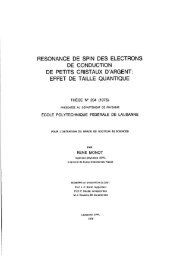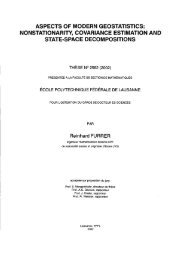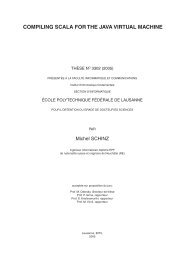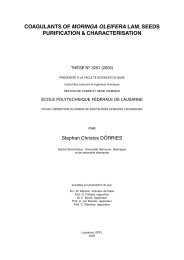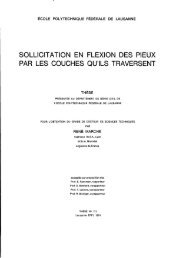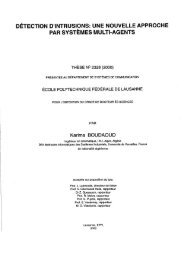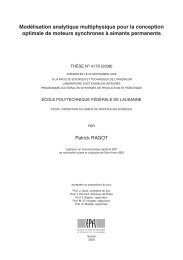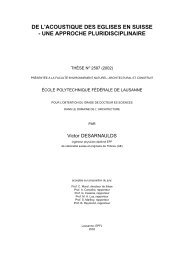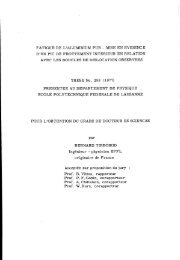Order and dynamics of model quantum antiferromagnets - EPFL
Order and dynamics of model quantum antiferromagnets - EPFL
Order and dynamics of model quantum antiferromagnets - EPFL
You also want an ePaper? Increase the reach of your titles
YUMPU automatically turns print PDFs into web optimized ePapers that Google loves.
<strong>Order</strong> <strong>and</strong> Dynamics <strong>of</strong> Model Quantum Antiferromagnets<br />
THÈSE N O 5081 (2011)<br />
PRÉSENTÉE LE 21 jUIN 2011<br />
À LA FACULTÉ SCIENCES DE BASE<br />
LABORATOIRE DE MAGNÉTISME QUANTIQUE<br />
PROGRAMME DOCTORAL EN PHYSIQUE<br />
ÉCOLE POLYTECHNIQUE FÉDÉRALE DE LAUSANNE<br />
POUR L'OBTENTION DU GRADE DE DOCTEUR ÈS SCIENCES<br />
PAR<br />
Martin MOURIGAL<br />
acceptée sur proposition du jury:<br />
Pr<strong>of</strong>. O. Schneider, président du jury<br />
Pr<strong>of</strong>. H. Rønnow, Dr M. Enderle, directeurs de thèse<br />
Dr Ph. Bourges, rapporteur<br />
Pr<strong>of</strong>. F. Mila, rapporteur<br />
Pr<strong>of</strong>. A. Tennant, rapporteur<br />
Suisse<br />
2011
Abstract<br />
The spin-1/2 Heisenberg <strong>antiferromagnets</strong> in one <strong>and</strong> two dimensions are important <strong>model</strong>s in <strong>quantum</strong><br />
magnetism in which many-body effects play a crucial role. Their collective excitations are associated with<br />
quasiparticles the interaction <strong>of</strong> which are difficult to describe. Neutron scattering <strong>of</strong>fers a very powerful experi-<br />
mental technique to study these excitations. In addition, it can reveal the nature <strong>of</strong> exotic ground-states favored<br />
by competing frustrated interactions or by an applied magnetic field. This thesis presents neutron scattering<br />
studies <strong>of</strong> four materials, each representing a <strong>model</strong> magnetic system.<br />
• Cu(DCOO)2·4D2O (CFTD) is a <strong>model</strong> realization <strong>of</strong> theS = 1/2 square-lattice antiferromagnet. It dis-<br />
plays Néel order <strong>and</strong> its long-wavelength excitations are well described by renormalized spin-wave theory. In<br />
contrast, the excitations at the magnetic zone-boundary display anomalous dispersion <strong>and</strong> intensity close to<br />
(π, 0). A polarized neutron study <strong>of</strong> the anomaly additionally reveals the presence <strong>of</strong> a transverse continuum<br />
associated with a lineshape that extends to high energies. Results for the transverse <strong>and</strong> longitudinal continua<br />
are compared with Quantum Monte Carlo <strong>and</strong> fermionic Resonating Valence Bond theories.<br />
• (5CAP)2CuCl4 (CAPCC) is aS = 1/2 square-lattice antiferromagnet with modest saturation magnetic<br />
fieldHs = 3.6 T <strong>and</strong>∼ 20% antiferromagnetic interlayer coupling. Its spin excitations, measured above sat-<br />
uration are used to determine the microscopic exchange parameters <strong>of</strong> its Hamiltonian, while the presence <strong>of</strong><br />
spontaneous magnon decay is investigated above the theoretically predicted threshold fieldH ∗ =0.76Hs.<br />
• CuSO4·5D2O is a <strong>model</strong> realization <strong>of</strong> theS = 1/2 antiferromagnetic Heisenberg chain. Its excitations<br />
are fully characterized in various regimes <strong>of</strong> applied magnetic field. In zero field, the presence <strong>of</strong> two- <strong>and</strong> four-<br />
spinon states is quantitatively confirmed, while the development <strong>of</strong> long-range Néel order is shown to preserve<br />
this picture qualitatively. In applied magnetic field, the excitations are studied with polarized neutrons <strong>and</strong> the<br />
existence <strong>of</strong> exotic psinons, anti-psinons <strong>and</strong> string-solutions continua is discussed.<br />
• LiCuVO4 is aS = 1/2 frustrated multiferroic chain material with competing ferromagnetic nearest <strong>and</strong><br />
antiferromagnetic next-nearest neighbor interactions. Its magnetic structure is found to be a perfect circular<br />
cycloid the chirality <strong>of</strong> which can be tuned with an applied electric field. In crossed electric <strong>and</strong> magnetic<br />
fields, the behavior <strong>of</strong> the cycloid closely matches with that theoretically predicted from the spin supercurrent<br />
scenario. A magnetic-field induced transition to short-range longitudinal order is also evidenced with polarized<br />
neutrons.<br />
The present work was carried out in the Triple-Axis Spectrometers group at the Institut Laue Langevin in<br />
Grenoble, France <strong>and</strong> in the Laboratory for Quantum Mangetism at the <strong>EPFL</strong>, Switzerl<strong>and</strong>.<br />
Keywords: Quantum magnetism, frustrated magnetism, Heisenberg <strong>model</strong>, antiferromagnetic spin-chain,<br />
square-lattice antiferromagnet, spin-wave theory, magnetic multiferroics, neutron scattering, polarized neutrons,<br />
triple-axis spectroscopy.<br />
iii
iv<br />
Résumé<br />
Les modèles de Heisenberg antiferromagnétiques dans le cas de la chaine et du réseau carré de spins demi-<br />
entiers sont parmi les plus importants en magnétisme quantique. Les effets à N-corps y jouent un rôle crucial<br />
de sorte que leurs excitations collectives sont associées à des quasiparticules dont les interactions sont difficiles<br />
à décrire. La diffusion des neutrons est une puissante technique expérimentale pour l’étude de ces dernières.<br />
Cette dernière est capable de déterminer la nature d’états fondamentaux favorisés par des interactions frustrées<br />
et/ou par l’application d’un champ magnétique. Cette thèse présente des résultats de diffusion neutronique<br />
pour quatre matériaux, chacun représentant un système modèle.<br />
• Cu(DCOO)2·4D2O (CFTD) est une réalisation du modèle de Heisenberg antiferromagnétique sur réseau<br />
carré. Le composé présente un ordre de Néel et ses excitations de gr<strong>and</strong>e longueur d’onde sont bien décrites<br />
par la théorie des ondes de spins renormalisées. Cependant, ses excitations en bord de zone magnétique ont<br />
une dispersion et une intensité anormale proche du vecteur d’onde (π, 0) . Une étude par neutrons polarisés<br />
révèle la présence d’un continuum transverse s’étendant à haute énergie. Les résultats concernant les continua<br />
longitudinaux et transverses sont comparés avec ceux obtenus par Monte Carlo Quantique et par une théorie<br />
RVB fermionique.<br />
• (5CAP)2CuCl4 (CAPCC) est une réalisation du modèle de Heisenberg antiferromagnétique sur réseau<br />
carré avec un champ magnétique de saturation raisonnable deHs = 3.6 T et un couplage antiferromagnétique<br />
entre plans de l’ordre de∼ 20%. Ses excitations de spins, mesurées au-dessus de la saturation sont utilisées<br />
pour déterminer les paramètres microscopiques de son Hamiltonien. A partir de ces résultats, l’étude cherche à<br />
déterminer la présence de désintégrations de magnons au-dessus de la valeur théoriqueH ∗ =0.76Hs.<br />
• CuSO4·5D2O est une excellente réalisation de la chaine de Heisenberg antiferromagnétique dans le cas de<br />
spins 1/2. Ses excitations sont complètement caractérisées dans divers régimes de champ magnétique appliqué.<br />
En champ nul, la présence d’état à deux et quatre spinons est confirmée quantitativement. La présence d’un<br />
ordre de Néel en dessous deTN ! = !90 mK n’influe pas sur ce résultat. En champ appliqué, les excitations du<br />
système sont étudiées grâce aux neutrons polarisés et l’existence de continua exotiques de psinons, d’antipsinons<br />
et de string-solutions est discutée.<br />
• LiCuVO4 est une réalisation de la chaine de spin frustrée avec des interactions ferromagnétique au premier<br />
voisin et antiferromagnétique au second voisin. Sa structure magnétique est une cycloïde parfaitement circulaire<br />
dont la chiralité peut être contrôlée par un champ électrique appliqué. En champs électrique et magnétique<br />
croisés, le comportement multiférroïque de cette cycloïde est compatible avec la théorie du supercourant de spin.<br />
Une transition induite sous champ magnétique vers un ordre local longitudinal est démontrée par neutrons po-<br />
larisés.<br />
Le travail présenté dans cette thèse a été préparé au sein du groupe Trois-Axes de l’Institut Laue Langevin<br />
à Grenoble et au Laboratoire de Magnétisme Quantique de l’<strong>EPFL</strong>.<br />
Mots-clefs: Magnétisme quantique, frustration magnétique, modèle de Heisenberg, antiferromagnetisme,<br />
chaîne de spins, réseau carré antiferromagnétique, théorie des ondes de spins, matériaux multiferroïques, diffusion<br />
de neutrons, neutrons polarisés, spectroscopie trois-axes.
Contents<br />
Introduction 1<br />
Quantum magnetism . . . . . . . . . . . . . . . . . . . . . . . . . . . . . . . . . . . . . . . . 1<br />
Thesis outline . . . . . . . . . . . . . . . . . . . . . . . . . . . . . . . . . . . . . . . . . . . . 3<br />
1 Neutron Scattering 5<br />
2 Anomalous excitations on the square-lattice – The case <strong>of</strong> Cu(DCOO)2·4D2O 11<br />
2.1 Spin excitations <strong>of</strong> square-lattice <strong>antiferromagnets</strong> . . . . . . . . . . . . . . . . . . . . 12<br />
2.1.1 Spin-wave theory . . . . . . . . . . . . . . . . . . . . . . . . . . . . . . . . . . . 12<br />
2.1.2 Experimental <strong>and</strong> numerical evidences for zone-boundary anomalies . . . . . . 17<br />
2.1.3 Beyond the spin-wave paradigm . . . . . . . . . . . . . . . . . . . . . . . . . . . 20<br />
2.2 The <strong>model</strong> antiferromagnet Cu(DCOO)2·4D2O . . . . . . . . . . . . . . . . . . . . . . 21<br />
2.2.1 Crystal structure <strong>and</strong> magnetic properties . . . . . . . . . . . . . . . . . . . . . 21<br />
2.2.2 Spin excitations <strong>and</strong> magnetic Hamiltonian . . . . . . . . . . . . . . . . . . . . 23<br />
2.3 Polarized neutron study <strong>of</strong> high-energy excitations in CFTD . . . . . . . . . . . . . . . 24<br />
2.3.1 Polarized neutron experiment . . . . . . . . . . . . . . . . . . . . . . . . . . . . 24<br />
2.3.2 Cross-section <strong>and</strong> imperfect beam polarization . . . . . . . . . . . . . . . . . . 26<br />
2.3.3 Data analysis . . . . . . . . . . . . . . . . . . . . . . . . . . . . . . . . . . . . . 28<br />
2.3.4 Single- <strong>and</strong> multi-magnon lineshapes . . . . . . . . . . . . . . . . . . . . . . . . 30<br />
2.3.5 Comparison with theory <strong>and</strong> discussion . . . . . . . . . . . . . . . . . . . . . . 31<br />
2.4 Summary . . . . . . . . . . . . . . . . . . . . . . . . . . . . . . . . . . . . . . . . . . . 34<br />
3 Search for field-induced magnon decay in (5CAP)2CuCl4 35<br />
3.1 Spontaneous magnon decay on the square-lattice . . . . . . . . . . . . . . . . . . . . . 36<br />
3.1.1 The origin <strong>of</strong> spontaneous magnon decays . . . . . . . . . . . . . . . . . . . . . 36<br />
3.1.2 Spin-wave theory predictions . . . . . . . . . . . . . . . . . . . . . . . . . . . . 38<br />
3.1.3 Numerical <strong>and</strong> experimental findings . . . . . . . . . . . . . . . . . . . . . . . . 41
viii Contents<br />
3.2 The square-lattice antiferromagnet (5CAP)2CuCl4 . . . . . . . . . . . . . . . . . . . . 42<br />
3.2.1 Synthesis <strong>and</strong> magnetic properties . . . . . . . . . . . . . . . . . . . . . . . . . 42<br />
3.2.2 Determination <strong>of</strong> the magnetic Hamiltonian . . . . . . . . . . . . . . . . . . . . 42<br />
3.3 Triple-axis study <strong>of</strong> the (5CAP)2CuCl4 excitation spectrum . . . . . . . . . . . . . . . 45<br />
3.3.1 Experimental Details . . . . . . . . . . . . . . . . . . . . . . . . . . . . . . . . . 45<br />
3.3.2 Zone-boundary anomaly in zero field . . . . . . . . . . . . . . . . . . . . . . . . 46<br />
3.3.3 Renormalized regime . . . . . . . . . . . . . . . . . . . . . . . . . . . . . . . . . 47<br />
3.3.4 Field dependence <strong>of</strong> zone-boundary excitations . . . . . . . . . . . . . . . . . . 48<br />
3.4 Summary . . . . . . . . . . . . . . . . . . . . . . . . . . . . . . . . . . . . . . . . . . . 50<br />
4 Dynamics <strong>of</strong> <strong>quantum</strong> spin chains in CuSO4· 5D5O 55<br />
4.1 The one-dimensional Heisenberg antiferromagnet CuSO4·5D2O . . . . . . . . . . . . . 56<br />
4.1.1 Crystal structure <strong>and</strong> magnetic properties . . . . . . . . . . . . . . . . . . . . . 56<br />
4.1.2 Brillouin zone <strong>and</strong> notations . . . . . . . . . . . . . . . . . . . . . . . . . . . . . 56<br />
4.1.3 Outline . . . . . . . . . . . . . . . . . . . . . . . . . . . . . . . . . . . . . . . . 57<br />
4.2 Quantitative study <strong>of</strong> CuSO4·5D2O spinon excitations inH= 0 . . . . . . . . . . . . . 57<br />
4.2.1 Determination <strong>of</strong> the Hamiltonian in the saturated phase . . . . . . . . . . . . 58<br />
4.2.2 Spinon excitations inH= 0 . . . . . . . . . . . . . . . . . . . . . . . . . . . . . 64<br />
4.3 <strong>Order</strong> <strong>and</strong> excitations in theH= 0 long-range ordered phase . . . . . . . . . . . . . . 72<br />
4.3.1 3D magnetic ordering . . . . . . . . . . . . . . . . . . . . . . . . . . . . . . . . 72<br />
4.3.2 Magnetic excitations in the ordered phase . . . . . . . . . . . . . . . . . . . . . 74<br />
4.4 Excitations in intermediate magnetic field 0
Contents ix<br />
5.5 Transition to short-range collinear order . . . . . . . . . . . . . . . . . . . . . . . . . . 113<br />
5.5.1 Vertical magnetic field set-up . . . . . . . . . . . . . . . . . . . . . . . . . . . . 113<br />
5.5.2 Longitudinal component <strong>of</strong> spin cycloids ? . . . . . . . . . . . . . . . . . . . . . 114<br />
5.5.3 Onset <strong>of</strong> incommensurate collinear order . . . . . . . . . . . . . . . . . . . . . . 117<br />
5.6 Summary . . . . . . . . . . . . . . . . . . . . . . . . . . . . . . . . . . . . . . . . . . . 118<br />
Conclusion 121<br />
A Polarized neutron cross-sections 123<br />
B Schematics <strong>of</strong> neutron scattering instruments 127<br />
C Spin-Wave theory with 1/S 2 interactions 131<br />
D 1/S renormalization in applied magnetic field 137<br />
E Diagonalization <strong>of</strong>H2 for CuSO4·5D2O 145<br />
Bibliography 147<br />
CV 157



